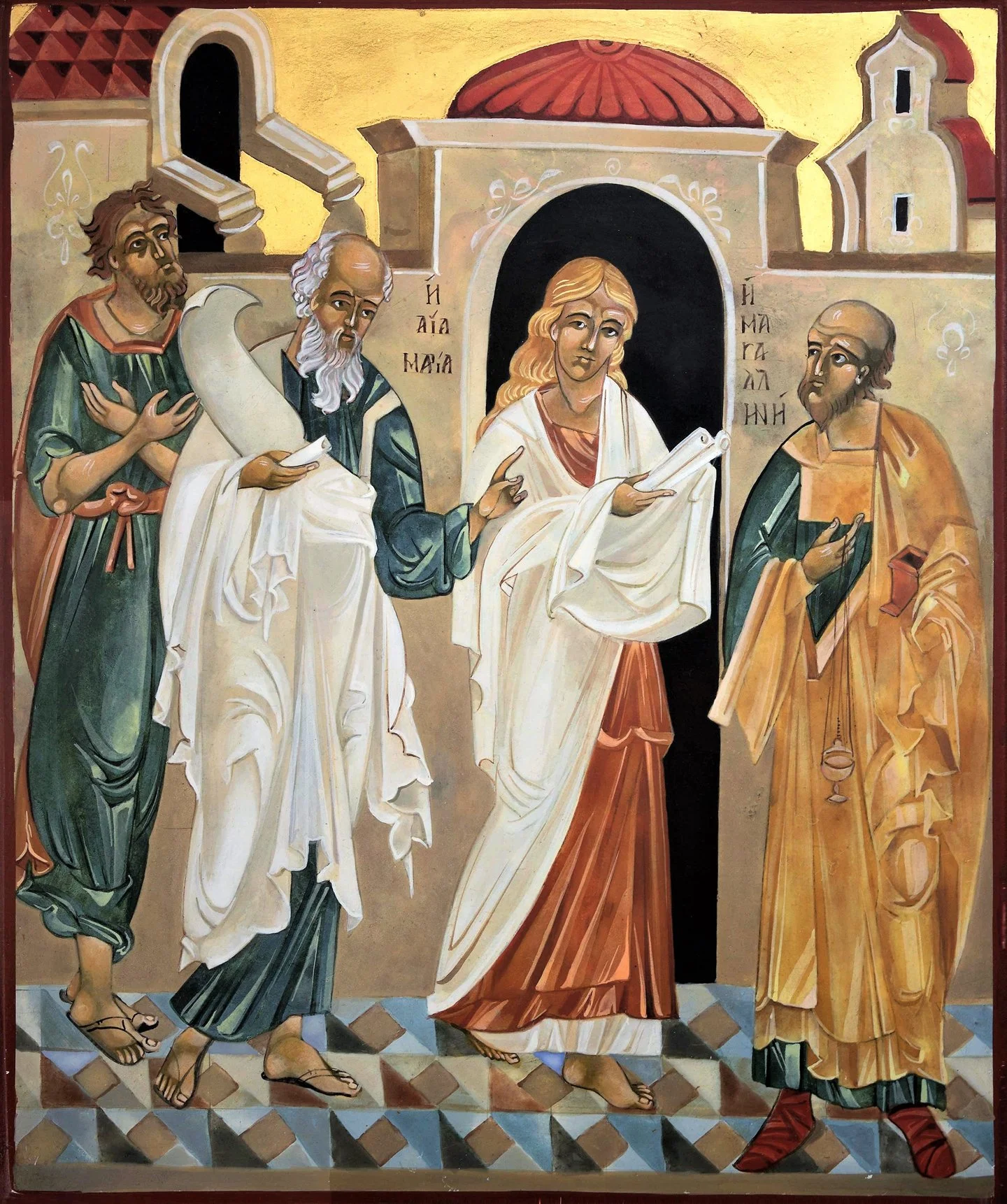Mary Magdalene: Apostle to The Apostles
“I saw the Lord in a vision and I said to him, ‘Lord, I saw you today in a vision.’ He answered and said to me, ‘Blessed are you that you did not waver at seeing me. For where the mind is, there is the treasure.’ —The Gospel of Mary 7:1-4
Back in October 2024, while I was living on a permaculture commune in San Miguel de Allende, Mexico, I was first introduced to Janzu. This season of my life marked the beginning of my trepidacious exploration of the Sacred Feminine.
Starting with my research into the Desert Mothers and Fathers, I realized a yearning to hear more from the women who walked with Jesus, and was frustrated by a lack of their firsthand narratives. Sure, we hear about amazing women of God in the Bible, but they are all male voices speaking about these women. Where were these women's voices? And why was I never told that Mary wrote a gospel?
I began to dig deeply, reading books written by Harvard-educated feminist theologians and Jungian theologian psychologists, all of which led me to finding the gospel written by Mary Magdalene herself. My mind was blown! Why had I never heard of this before? And why were her words not in the canonical New Testament?
I wanted to know more about her as a person, her walk with Jesus, her role in the early Church, and why she wasn't a bigger figure in my American evangelical upbringing. I'm still amazed at what I found about the first female mystic, Mary Magdalene.
The Gospel of Mary
She was never meant to disappear. Yet for centuries, Mary Magdalene's name has been stained by misidentification, her gospel buried, her voice silenced beneath layers of patriarchal distortion. Depending on your faith tradition, you may know Mary as a prostitute or even as the wife of Jesus, but neither seems to be true.
"Mary's authority stems from both her closeness to Jesus and the fact that Jesus has told her things that he told no one else. There is no suggestion in the story of physical or sexual intimacy between Jesus and Mary. Indeed, the focus is on an intellectual and spiritual connection between them. The idea of a sexual relationship between Jesus and Mary is almost certainly a modern fixation, not an ancient notion. This gospel not only concentrates on Mary Magdalene, but its story points directly to Mary's authority as a woman leader."—Hal Taissig, A New New Testament
Today, the Church names her "apostle to the apostles." But that title barely scratches the surface of who she was and what she still offers us.
Mary Magdalene wasn't just a witness to Jesus' death; she was the first witness of His resurrection—she was a keeper of the Christ mystery, a bearer of wisdom so intimate and embodied that it terrified systems built on control. She represents the Sacred Feminine not as a soft symbol, but as a force of love rooted in knowing.
In The Gospel of Mary—a non-canonical text lost to time and rediscovered in fragments in the 19th century—we hear a voice long suppressed:
"Beware that no one lead you astray saying, ‘Look over here!’ Or ‘Look over there!' For the Child of Humanity is within you! Follow it! Those who seek it will find it. (Gospel of Mary, 4:3–7)
Her gospel doesn't begin with miracle stories or lineages. It starts with grief—the disciples are confused and afraid after Jesus' death. It is Mary who stands steady. It is Mary who comforts and reminds them of the truth.
"Do not weep and be grieved nor let your hearts be irresolute. For His grace will be entirely with you and will protect you." (Gospel of Mary, 5:2–4)
And when she shares the secret teachings the Lord gave her, what happens? Peter questions her. Andrew dismisses her. Levi defends her.
It's a familiar cycle: a woman speaks from deep, embodied experience, and the men around her question her authority. But Mary doesn't argue. She offers what she knows and leaves space for their response. This is the way of the mystic—not force, but invitation.
Her gospel speaks of the soul's ascent through the realms of fear, desire, and ignorance. A path inward, toward wholeness. Toward the true Self—Christ consciousness within.
"The soul answered, saying: 'I saw you. You did not see me nor recognize me. I served you as a garment, and you did not know me.'"—(Gospel of Mary, 10:10–15)
This is lived revelation. The kind you feel in the body. The kind that emerges when we pray, not to be taught about God but to know (gnosis) God. Mary Magdalene's gospel is not a threat to orthodoxy—it is a mirror.
It invites us to reconsider how we've defined sin, salvation, authority, and embodiment. It dares us to trust inner wisdom—not in isolation, but in communion with the Holy Spirit.
In her, I see a pattern:
Devotion that doesn't flinch in the face of death.
Embodiment that isn't ashamed of its knowing.
Leadership that flows from intimacy, not hierarchy.
She stayed when others fled. She listened beyond fear. She spoke when silenced.
The Sacred Feminine
I've come to believe that women play a special role in God's plan for humanity, beginning with Eve, who was the catalyst that ushered us into the knowledge of good and evil.
In the New Testament, we find Mother Mary. YHWH, who created Adam from dust, could have given life to Jesus in the same way. Instead, God chose to change history through a courageous woman's yes.
Then we see Jesus choose Mary Magdalene to be the first person He revealed Himself to after His resurrection. He chose Mary to be the first to spread the Good News, to be the apostle to the apostles. I believe YHWH is still choosing women to play essential roles in the story of humanity’s conscious evolution, to demonstrate healing of the Sacred Feminine that exists in all of us.
What intrigues me so much about Mary Magdalene is her embodiment of the Sacred Feminine. As Elayne Kalila Sophia Doughty writes in the foreword of Magdalene Unveiled:
“She is the mirror of the Feminine in all of us, not passive, not soft alone, but wild, sovereign, undivided. She is love as truth-telling. Devotion as fire. Embodiment as a spiritual path... The unveiling of the Magdalene is not happening in isolation. It is part of a larger collective awakening, a return to what has been exiled, a reweaving of what was torn. We see it in the rise of women’s voices. In the dismantling of outdated structures. In the hunger for a more embodied, heart-centered, and sovereign way of being.”
A Return to the Embodied Good News
Mary Magdalene has become more than a footnote in my faith journey with Jesus—she’s become a threshold.
Through her gospel, I’ve encountered a Christianity that lives in the body, that speaks through intuition, that honors love as a force of truth. Her voice, once silenced, now echoes in the collective hunger for wholeness. And in this echo, I hear a call—to reclaim what was exiled. To re-embody what was buried. To trust Christ Jesus who lives within me.
This isn’t about rewriting the story of Jesus.
It’s about recovering what was lost in translation.
It’s about recognizing that the Good News isn’t only in the canon—it’s also in our marrow, our wombs, our longings, our dreams.
Mary’s gospel reminds us that the kingdom of God is not only something to believe in—it’s something to become.
So as I continue to walk this path, I carry her words in my heart. I remember her steadiness when I want to shrink. Because Magdalene didn’t disappear—She just went underground. And now, she rises in every one of us ready to remember.
Disclosure: This post may contain affiliate links. If you click through a link and make a purchase, it will earn me a small commission, at no additional cost to you! See our disclaimer for details.








For the Activist, compassion is not a concept — it is a calling. Justice is not ideology — it is worship. Action is not distraction — it is prayer embodied. This pathway is where the heart of God touches the wounds of the world. Where faith becomes flesh and love becomes action.